U.S. Department of Transportation
Federal Highway Administration
1200 New Jersey Avenue, SE
Washington, DC 20590
202-366-4000
FHWA Resource Center
Click here for the PDF Version of the Environmental Quarterly
To view PDF files, you need the Acrobat® Reader®
Summer 2012
INSIDE
• Dave Gamble, FHWA Section 4(f) Virtuoso, Retires
• Understanding the Fabric of Communities
• FHWA Launches the Transportation Liaison Community of Practice Website
• Social Media Changes Communication Landscape, Part II
• TNM 2.5 Now Available Free of Charge
• Look What the Wind Turned Up
• Environmental Calendar
LETTER FROM THE EDITOR
Welcome to the latest edition of the Environmental Quarterly (or almost Quarterly). This is a bitter sweet time for me and FHWA as we bid Dave Gamble a fond farewell and wish him a very happy and a well-deserved retirement. I have known Dave for many years as a peer, his supervisor and friend. There are a very few people around that know as much about Section 4(f) or have cared for it as passionately as Dave. While some may consider that a little strange, including me, his dedication to it has made an incredible difference in protecting our cherished parks, recreation areas, refuges and historic sites while advancing the FHWA program. Let us all give Dave a round of applause.
Sincerely,
Lamar Smith
Environment Technical Service Team Leader & Editor–in-Chief
Phone: (720) 963-3210
E-mail: lamar.smith@dot.gov
Dave Gamble, FHWA Section 4(f) Virtuoso, Retires
By Lamar Smith, and MaryAnn Rondinella, FHWA Resource Center Environment Technical Services Team
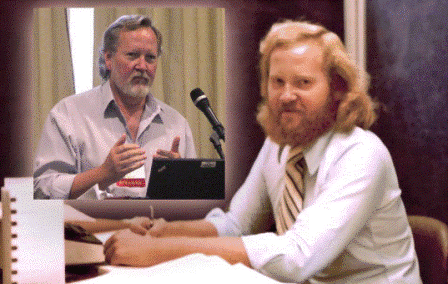
Photos of Dave Gamble concluded more than three decades of dedicated Federal service in June, 2012. (Photos, Stephanie Stoermer [2010] and Dave Gamble [1978],FHWA)
After 35 years of distinguished Federal service, Dave Gamble retired effective June 2, 2012. One of FHWA’s foremost experts on the U.S. Department of Transportation Section 4(f) law, regulation and policy, Dave has played a crucial role in shaping the agency’s understanding and implementation of this important law. In addition to assisting with development of guidance, Dave has been much sought after as an instructor. He has led workshops on Section 4(f) and related laws and regulations throughout the country. He has also fielded questions from colleagues and stakeholders and grappled with challenging issues on projects of all types and sizes.
Before riding off into the sunset, Dave generously shared his experiences and reflections with
Environmental Quarterly Chief Editor Lamar Smith and Resource Center teammate MaryAnn Rondinella.
EQ: What made you decide to join FHWA?
Dave: My original career aspirations included visual arts, graphic design, advertising, or motion pictures. My parents said they’d support my career choice. They also suggested that I get a degree in a practical subject so I’d have a paying job to fall back on! That turned out to be wise advice. So I earned my bachelor of science degree in Civil Engineering at West Virginia University with an emphasis on structural engineering. My grandfather was a district engineer for the WV State Roads Commission, and my father was a project supervisor for the state on many projects. I had also worked for the state throughout college and briefly after I graduated. A friend at WVU was offered a job by FHWA, and spoke very highly of the agency and its training program and benefits. So I began to look into it. The training program and the ability to work in different parts of the country had tremendous appeal. So I applied, and was hired.
EQ: What were some of the highlights of your early career as a highway engineer?
Dave: One of my earliest assignments was in Minnesota, as an assistant area engineer. To this day, Minnesota has a very strong environmental ethic. I had the opportunity to take on more environmental duties and worked on important projects, such as the Great River Road. I also worked on projects that required the preparation of environmental assessments and environmental impact statements, and Section 4(f) evaluations. I worked on projects with more complex environmental issues and extensive public involvement. As an area engineer in the Illinois Division, I volunteered to take on more environmental duties.
EQ: So you didn’t find the transition from highway engineering to the environmental discipline to be hard or frustrating?
Dave: Not at all. I found working on controversial projects with complex environmental issues challenging and intriguing. Many environmental issues don’t have clear-cut answers. They required me to take the time to really take a hard look at the issues and use professional judgment. They also gave me the opportunity to work with our Headquarters and staff from around the agency.
EQ: You are one of only a handful of FHWA employees with extensive experience in Division Offices, Headquarters, a Region Office, and the Resource Center. What was it like making these transitions?
Dave: After 10 years in the field, I was offered a position in Headquarters. I was very fortunate to join headquarters at a time when environmental stewardship was becoming an integral part of the agency’s day-to-day operations. I was able to work with some of our forward-thinking people at the time: Gene Cleckley, Harter Rupert, Bob Gatz, Mike Saunders and Fred Skaer among them. The Federal-aid Highway Program has always had a very positive effect on the quality of life in this country. With more diligence paid to environmental ethic, it’s even better. I then followed my manager Bob Gatz to the Region 3 Office in Baltimore. After the Region office closed, Albany, NY was being considered as a possible location for the Eastern Resource Center. By that time, I decided I wanted to stay in Baltimore.
When FHWA decided to locate a Resource Center office in Baltimore, I decided to stay after Bob retired in 1999. And I’ve been here ever since.
And there have been very gratifying experiences, such as completion of the new Woodrow Wilson Bridge. I was initially doubtful about the bicycle/pedestrian trail on the bridge and whether very many people would use it. But, it is seeing a great deal of use, even on weekdays. That is very gratifying.
EQ: You’ve seen a lot of changes in the agency and how we do business. What advice or words of wisdom can you share with your colleagues?
Dave: The pace of how we operate is one of the most dramatic changes I’ve noticed. With all the technological tools we have to assist us, we are more accessible. But we are also more prone to multitasking. While that may increase productivity on one hand, it creates a challenge to stay focused and thoroughly complete tasks at hand.
Always take the opportunity to improve on your own without having to be told to take a class or complete some web-based training. You can do this by setting aside some rare free time each week to dive into some aspect of the program. Take Section 4(f) as an example…pick a topic and research it by reading the applicable section of the regulation, the preamble to the regulation, and the Section 4(f) Policy Paper. Go online and run a search of ReNEPA to see what others had to say about it. Call someone to talk about it. At the end of each exercise, you’ll be that much farther along.
Regarding Section 4(f) in particular, don’t struggle with it. Make it work for the program. Use the flexibilities that are available.
Also, take good care to develop good relationships with your peers. There is so much to be gained by establishing good lines of communication and trust. I’ve made so many friends along the way, something I’ll always value.
EQ: Thank you so much for your time and your insights. Enjoy a long and happy retirement!
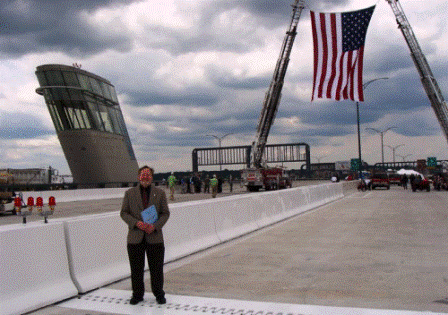
Photo of Dave Gamble at the Woodrow Wilson Bridge Dedication, May 2008. (Photo, Dave Gamble, FHWA)
Understanding the Fabric of Communities
By Anne Morris, Anne Morris & Associates
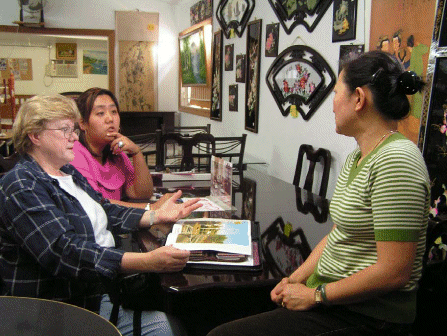
Photo of people during outreach efforts to an Asian-American community in a local Chinese furniture store. (Photo: Anne Morris)
Recently, I was asked to make a presentation on “conflict in environmental justice communities.” It took me a few days to understand why “environmental justice communities” and not just conflict in any community. The perspective of many of us that do public involvement, while we may be well meaning, can be substantially different from the perspective of those in low-income and minority communities. If we fail to understand the communities’ perspectives, we can misunderstand the impacts our projects have on the communities and degrade or further degrade them. Today our reliance on raw data, rather than on a knowledge and understanding of the fabric of communities has the potential to cause unnecessary conflicts between agencies and those they serve. In short, we need to revisit the past and go back into the communities.
In the 1970s and 1980s, the Census was available only on paper and much of the 1980 Census still is not available electronically. Access to the Census was predominantly through college libraries and state libraries found in the state’s capital. Copiers, when available at these locations, were slow and expensive. Because of the difficulty in accessing Census information and the limited data provided, practitioners were forced to go into communities to understand the fabric of those communities, identify familial relationships, and uncover dependencies between individuals and families. In low-income communities, individuals by necessity often heavily depend on their neighbors because they cannot afford all of the services they may need. A woman might keep children in her home in exchange for someone fixing her car, taking her mother to the doctor, washing and ironing her clothes, buying food and fixing her a meal, or any number of other things. It is bartering or the use of “social capital” that has become the currency of daily life. Without understanding these relationships and others, it is unlikely that a project’s impact on a community would be accurately construed and easily creates another source of conflict. Some State DOTs have understood the need to go into these communities for some time and one of the first non-secretarial positions created by State DOTs for women was community planner. These women were often former social workers or those who had worked with non-profit organizations.
With the advent of the Internet and availability of computers in the 1990s and 2000s, Census and other data sources became accessible from an office or home computer. The amount and variety of data coupled with the convenience of not having to leave the comfort of one’s chair caused practitioners to become dependent on data - cold, two-dimensional, aging daily, passive – data. As a result, decisions on how projects would impact communities were made by practitioners based on data and from their own perspectives that reflected their own educational attainment, social strata, income level, or race or ethnicity and not the perspective of those in the communities. Without an understanding of the culture and fabric of those communities, the interdependencies of individuals, the things they physically, emotionally and spiritually value, these different perspectives often came into conflict. Unfortunately, these conflicts frequently take place at Public Hearings, as in many cases this is the first time those in the communities have been given the opportunity to see the preferred alternative.
As this country’s demographics continue to change, there will be a greater need for practitioners who are comfortable not only collecting and analyzing data, but also, going back into communities. State DOTs and their consultants will need to hire public involvement professionals who mirror their clients racially and ethnically, are bilingual, exhibit good interpersonal skills, and have a background or experience in anthropology, customer service, social work, non-profits, teaching, health care, or other appropriate field. In this way, the interwoven intricacies of the affected communities can be identified, understood, addressed, and incorporated more sensitively into transportation projects.
FHWA Launches Transportation Liaison Community of Practice Website
By Jaimye Bartak, VOLPE, Contributor
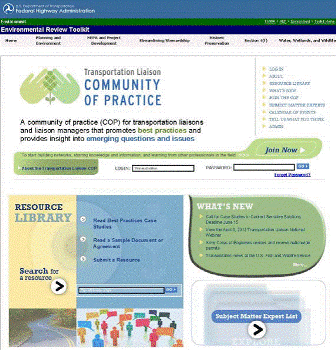
Screenshot of the Transportation Liaison Community of Practice Website on FHWA’s Environmental Streamlining Toolkit.
As allowed by Section 6002 of the Safe, Accountable, Flexible, Efficient Transportation Equity Act: A Legacy for Users (SAFETEA-LU), a State Department of Transportation (State DOT) can fund staff positions at Federal and State resource agencies that are dedicated to working on State DOT projects for environmental streamlining and related planning activities. These positions, collectively known as transportation liaisons, are located throughout the country, and have professional expertise in biology, air and water quality, historic preservation, and other environmental disciplines. Liaison agreements can be written to include involvement in early transportation planning and project development activities.
To increase awareness of the role of transportation liaisons and to enrich the liaison state of practice, the Federal Highway Administration (FHWA) recently launched a new website devoted to the Transportation Liaison Community of Practice. The Community of Practice (CoP) website is an outgrowth of the 2009 State Transportation Liaison Funded Positions Study which examined the use of transportation liaisons across the country as well as subsequent efforts to engage liaisons and their managers on the support and tools needed to maximize liaison effectiveness.
The FHWA is encouraging current liaisons, liaison managers and interested State DOT and resource and regulatory agency staff to register for the website for full access to its features, which includes a resource library, subject matter expert list, and forum to announce news and events. A discussion board is also under development. State DOTs interested in establishing liaison programs will find helpful sample agreements and information on the benefits liaisons can provide.
Additionally, the FHWA is currently soliciting resources for the website from registered users, such as case studies, articles, and best practices, as well as news about related programs and events. Public users will be able to access the calendar and general information about the role and benefits of liaisons, as well as profiles of individual liaisons and the work they do in the field.
For more information about the Transportation Liaison Community of Practice, please visit the CoP website.
For more information about transportation liaisons and their role in SAFETEA-LU Planning Activities please visit the FHWA’s Environmental Review Toolkit page.
Social Media Changes Communication Landscape, Part II
By Katiann Wong-Murillo, FHWA Resource Center; Jocelyn Jones, FHWA Resource Center; and Tom White, FHWA Office of Public Affairs
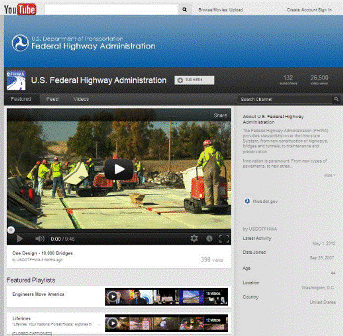
Screenshot of FHWA’s YouTube Page.
In the last issue we defined the term ‘social media’ and discussed its impact on the way we communicate. For example, in March of this year, Facebook logged 900 million users, making it by far the number one social networking site on the planet. Younger generations view email as passé – they interact via text messages and Twitter “Tweets”. Family photos are no longer collected into glossy albums, but shared across the Internet. The question is not whether or not the public, companies, Government agencies, and organizations will embrace social media. It is how – because it’s already here.
In Part II of this series, we will discuss different types of social media platforms, and the pros and cons of each. We will discuss the big five: Facebook, YouTube, Twitter, Flickr, and blogs.
Facebook
At the end of March 2012, Facebook reported 901 Million subscribers, and expects to reach 1 Billion by the end of this calendar year (source: http://bit.ly/IRLQZD). But what exactly is Facebook? Facebook is a free social networking Web site that allows registered users to create profiles, upload photos and video, send messages and keep in touch with friends, family, coworkers and associates. Users can connect to friends, family and colleagues by requesting to “friend” or subscribe to their Facebook pages.
Each user is given a virtual bulletin board—or “wall”—where he or she can post status updates, photographs, Web links, and videos. Their friends who subscribe to their pages can then see their posts in real time. Each new post is displayed on a timeline as a news ticker update.
In addition to subscribing to friends’ pages, users can also subscribe to Facebook feeds for corporate, organization, or Government agency pages. These types of Facebook pages are known as organization pages and do not require acceptance of friend requests from users. Rather, users simply click a button labeled “Like” to subscribe to the organization page news feed.
YouTube
YouTube is a video sharing service. Users can sign up and upload videos and share them with anyone on the Internet. Casual users are allowed to upload any number of videos (as long as they don’t upload copyrighted material), but are limited to a maximum video length of 15 minutes. Organization YouTube channels do not have time limits.
YouTube is the most popular video sharing site, as evidenced by the fact that it is the second most popular search engine on the Internet—second only to Google.
Twitter
These days, Twitter is an almost expected companion to Facebook. It allows users to get their messages out to a larger audience, interact with their stakeholders in new ways, answer questions promptly, and provide vital information quickly.
Twitter is a text messaging service that allows users to post messages to a network of contacts, or “subscribers”. Instead of sending dozens of emails or text messages, Twitter sends one message to a Twitter account, and the service distributes it to all of that account’s Twitter subscribers simultaneously.
Twitter offers brief snapshots of information (140 characters) and allows users to disseminate quick and concise updates. Twitter is often the Social Media tool of choice for individuals on the go who just want a quick piece of information. And it allows subscribers to relay information to their subscribers by sharing “Tweets” or “re-Tweeting” the text messages, potentially giving the initial message a much wider audience.
Hot topic areas can be marked with hash tags, and every time that tagged word appears in a Tweet, it will show up in a user’s feed if he or she searched for that term. For example, at the
Department of Transportation, safety is a top priority. Tweets that centered on safety are tagged “safety”.
(As a side note, the Federal Highway Administration officially launched their new Twitter account on June 20, 2012. You can follow FHWA at: @USDOTFHWA.)
Flickr
Flickr is an image hosting service that allows users to share photos on their Flickr pages, and embed them in other social media and websites. Images hosted can be in varying resolutions – lower resolution images for on-screen viewing, or higher resolution images for photo printing. Users have the option to purchase higher resolution photos for printing. This works well for those who want to share wedding, vacation, or other memorable images among friends and family. Users can also organize their photos to create photo calendars, greeting cards, and glossy photo albums deliverable by mail.
Blogs
Blogs are the predecessors of today’s multimedia applications. A blog is a discussion Web site or online diary consisting of posts displayed in reverse chronological order with the most recent post listed first.
The first blogs were the work of a single individual or a small group, and often were themed on a single subject. More recently "multi-author blogs" (MABs) were developed, with posts written by multiple authors. Blogs offer two-way interaction in the form of comments underneath posts, but few have access to post the main posts on the page. Popular micro-blogging sites like Facebook and Twitter have superseded blogs, which have lost popularity in favor of these newer multimedia tools.
The following is a table comparing the pros and cons of the social media tools we just discussed:
Social Media Pros and Cons
PROS CONS
Facebook
PROS
• Biggest audience; most popular social media site.
• Can share status updates, images, Web links, and videos.
• Can link to other social media applications.
• Allows interaction.
• Free service.
CONS
• Privacy concerns.
• Pictures are low grade so cannot be used for print applications.
YouTube
PROS
• Huge audience; most popular video sharing site.
• Can embed videos in other Web pages.
• Easy to caption videos for 508 compliancy.
• Links directly with Facebook and other social media applications.
• Allows interaction (comments; sharing).
• Easily tracked insights.
• Free service.
CONS
• Can only upload videos 15 minutes or shorter (unless you have a corporate account).
Twitter
PROS
• Instant messaging service.
• “Re-Tweeting” can allow for your message to go viral.
• Good companion service for Facebook.
• Social Media App of choice for smart phone users.
• Fastest social media out there – immediate messaging.
• Reaches a large number of people.
• Allows interaction.
• Free service.
CONS
• Only allotted 140 characters per Tweet.
• Text only.
Flickr
PROS
• Free image hosting site.
• Can share your photos with others.
• Can embed pictures in other Web pages.
• Allows you to create calendars, greeting cards, and photo albums with your images.
• Can link directly with Facebook and other social media applications.
• Reaches a large number of people.
• Allows interaction.
• Basic service is free.
CONS
• High-resolution images for printing cost money to download.
• Limited number of uploads per month, unless you pay a subscription fee.
Conclusion
Using social media can build relationships quickly and easily with those we serve. Government agencies are using social media to inform multiple audiences about current and completed projects and initiatives effectively and efficiently. Other uses include recruiting potential employees, promoting events, and sharing photographs and video clips from recent events and speaking engagements. Social media is a channel through which agency officials hope to engage readers, build interest, and seek public feedback and input. Keep in mind, social media is not all “motherhood and apple pie.” Managing and maintaining all social media sites require full time manpower to keep the sites engaging, up-to-date, and keep viewers interested. Although there are some concerns with employee use of social media and how to manage it internally, the benefits from using these social tools and platforms will show a positive return on investment and, therefore, should become integrated into our business model in the future.
FHWA Traffic Noise Model Version 2.5: Now Available Free of Charge
By MaryAnn Rondinella, FHWA Resource Center
The Federal Highway Administration (FHWA) Traffic Noise Model (TNM) Version 2.5 is now available free of charge. The software and supporting documentation can be downloaded from the FHWA noise website.
The FHWA TNM Version 2.5 is required for noise analyses for Federal highway projects, pursuant to 23 CFR 772.9(a). Copies of the FHWA TNM and updates were sent to State transportation agencies free of charge. Now consultants and other stakeholders can obtain the
FHWA TNM 2.5 without paying a fee. Technical documents are also available at the FHWA noise website.
FHWA and its partners are continuing to develop FHWA TNM Version 3.0, subject to available funding. Version 3.0 will include suggested improvements and enhancements from current users of FHWA TNM 2.5. For information about FHWA TNM Version 3.0, please visit the FHWA noise website.
For more information, please contact Mark Ferroni, FHWA Noise Team Leader, mark.ferroni@dot.gov or Adam Alexander, FHWA Noise Specialist,
adam.alexander@dot.gov.
Look What the Wind Turned Up
By Mary Finch and David Williams, FHWA Michigan Division
It all started with the exposed roots of a tree. The tree, lying on its side with its roots pulled from the ground, had something to share. There, among the roots was a spear point probably buried 600 to 1000 years ago in a food cache. The wind whispered, “We are in the land of the Anishinabek and there is much for you to learn from this land before you disturb it to build your new road.”
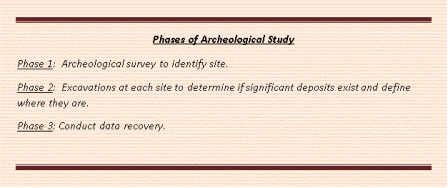
Graphic showing the Phases of Archeological Study.
Look Below the Surface
The Michigan Department of Transportation (MDOT) determined that a project to extend U.S. 231 across the Grand River was needed and to do so an archeological study of the 40+ acres would need to be completed. A project for a new road is not common in Michigan--most of the State’s projects fall into the category of “reconstruction,” where a road is built within the footprint of the previous roadway. Not this time.
The land required for the U.S. 231 project had not been built on or ever plowed. Except for some logging many years ago, the land had not been disturbed. After completing the Phase 1 archeological study, and coordinating with the local tribes, it was clear that additional field investigations and studies would be necessary.
Involve Your Tribal Partners to Develop a Plan
Before further investigations began, MDOT and the FHWA – Michigan Division invited the 12 Federally-recognized Tribes in Michigan to help create a Tribal Participation Plan for the project.
Several of the Tribes helped write the plan, which included the respective areas of interest for MDOT, FHWA and the Tribes. Interests included:
• Describing how communications and activity updates would be addressed and incorporating these in a Communication Plan
• Providing access to the site by Tribal members for spiritual blessings/ceremonial activity and during excavations.
• Establishing safety protocols for the site visits, including wearing vests, hardhats and sturdy shoes during all visits to the site, with the vests and hardhats to be provided by MDOT.
Most importantly, the Tribal Participation Plan spelled out the disposition of inadvertent discoveries of ancestors. When the Tribes asked if their ancestors could be re-buried as close to the site as possible, MDOT considered an innovative approach. MDOT suggested a plan to set aside a small portion of the right-of-way as a “scenic strip” that could be protected and used for re-interment. The Tribes recognized that it was a major accommodation to their beliefs to allow the ancestors to remain as close to their original burial sites as possible. This was also the first time MDOT had considered such an arrangement.
Maintain Open and Continuous Communication
Weekly reports were provided to FHWA and Tribal representatives. Monthly site visits and briefings from the archeologists performing the research were also conducted. The site visits were very informative, with the Field Director, Michael J. Hambacher, PhD, Commonwealth Cultural Resources Group, Inc. pointing out areas of interest and answering questions from the group.
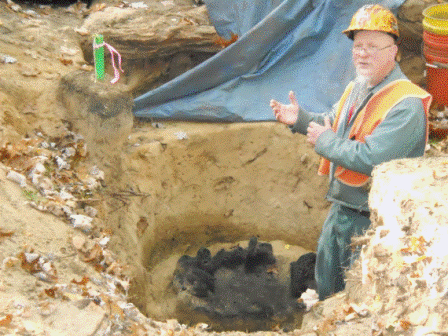
Photo of Michael J. Hambacher, PhD, Field Director with charcoal in feature. (Photo by Mary Finch, FHWA)
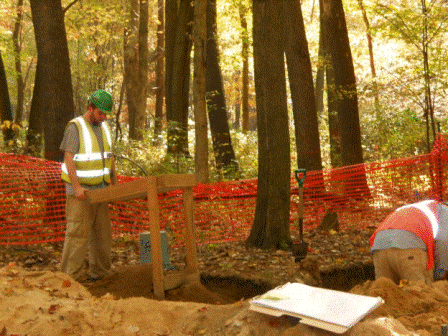
Photo of an unidentified archeologists screening soil from the U.S. 231 site. (Photo by Mary Finch FHWA)
Woodland Period
3,000 to 2,300 Years Ago (1000-300 BC) Early Woodland Period: Early Pottery, Gathering and Permanent Settlements.
1,500 to 350 Years Ago (300 BC -500 AD) Middle Woodland Period: Common Religious Practices, Cultural Interaction (more trade).
1,500 to 350 Years Ago (500-1620 AD) Late Woodland Period: Use of Bow and Arrows, Agricultural Beginnings.
Document What was Found and Tell the Story
For Phase 3 of the archeological study, the area was divided into four clusters. In each cluster, surface depressions were identified for excavation. The number of depressions within each cluster ranged from four depressions in Cluster 1 to seventy-five depressions in Cluster 4. A single 2 meter x 2 meter excavation unit within Cluster 4 yielded 275 pottery fragments of Late Woodland age (circa 500 – 1620 AD). Since many of the finds were recovered from food caches where items had been stored for hundreds of years, some reconstruction of the past hunting and gathering habits could be made.
Recovered cultural materials included small bone drills, spear tips, pottery fragments and grinding stones. The nature of these materials suggest that the area--located on the terrace of the Grand River--was used during short-term occupations for gathering of clams, sturgeon, nuts, berries and perhaps hunting deer or other small animals.
Each monthly visit would bring something new and we would learn more about the life that Tribal people had lived in this area in the past. The land shared its history to all who listened to the wind.
It was a successful Tribal Participation Plan and MDOT, FHWA and the Tribal representatives all came together as a group to learn more about Michigan’s past and preserve the information for the future. We anticipate that the final report will be issued in early 2013, after the analysis of the cultural materials is completed.
For more information about the U.S. 231 Tribal Participation Plan and related efforts, please contact Mary Finch, FHWA Michigan Division, 517-702-1853 mary.finch@dot.gov or David Williams, FHWA Michigan Division, 517-702-1820 david.williams@dot.gov.
What's Going On?
September 2012
Sept. 9-12
Northeastern Transportation & Wildlife Conference, Hosted by Maine DOT
Location TBD
November 2012
Nov. 1
Deadline to submit abstracts for ICOET’s 7th Biennial Conference
http://www.icoet.net/ICOET_2013/
Nov. 4
Daylight Saving Time ends in the U.S.
Nov. 12-13
12th National Light Rail Conference, ‘Sustaining the Metropolis: LRT and Streetcars for Super Cities’
Salt Lake City, UT
http://www.trb.org/Calendar/Blurbs/166277.aspx
December 2012
Dec., TBD
TRB Energy Development Impacts on Transportation Workshop
Dallas, TX
http://www.trb.org/Calendar/Blurbs/167634.aspx
January 2013
Jan. 13-17
Transportation Research Board 92nd Annual Meeting
Washington, D.C.
http://www.trb.org/AnnualMeeting2013/AnnualMeeting2013.aspx
June 2013
June 23-27
ICOET 7th Biennial Conference, ‘Canyons, Crossroads, Connections’
Scottsdale, AZ
http://www.icoet.net/ICOET_2013/
For additional conferences and events, see https://www.fhwa.dot.gov/hep/calendar.htm.
CONTACT INFORMATION:
Federal Highway Administration
Resource Center
Editor-in-Chief
Lamar Smith, Environment Technical Service Team Leader
Phone: (720) 963-3210/Fax: (720) 963-3232
E-mail: lamar.smith@dot.gov
Editorial Board Members:
Brian Smith, Biology/Water Quality Specialist
Phone: (708) 283-3553/Fax: (708) 283-3501
E-mail: brian.smith@dot.gov
Stephanie Stoermer, Environmental Program Specialist/Archeologist
Phone: (720) 963-3218/Fax: (720) 963-3232
E-mail: stephanie.stoermer@dot.gov
Deborah Suciu-Smith, Environmental Program Specialist
Phone: (717) 221-3785/Fax: (717) 221-3494
E-mail: deborah.suciu.smith@dot.gov
Melissa Toni, FHWA NY Division
Phone: (518) 431-4125 x 227
E-mail: melissa.toni@dot.gov
Production Schedule:
Due to our Quarterly publication schedule, all article submissions for future issues are due to the Editor-In-Chief by the 10th of March, June, September, and/or December
Getting the news:
*If you would like to receive this newsletter electronically, please send your email address to: marie.roybal@dot.gov